The most effective way to prevent blisters is by creating a system that minimizes friction and manages moisture. This begins with properly fitted boots that you've broken in, paired with the right socks, and includes proactively treating "hot spots" with tape before they become blisters.
Blister prevention is not about a single product, but a holistic system. The core principle is to manage the relationship between your foot, your sock, and your boot to eliminate friction and keep your skin as dry as possible.

The Three Causes of Blisters
To prevent blisters, you must first understand what causes them. They are the result of three factors working together: friction, moisture, and heat.
Friction: The Primary Culprit
Friction is the direct mechanical force that causes blisters. When your boot is too loose, your heel or toes can slide, rubbing against the sock and boot interior with every step.
This repeated rubbing separates the outer layer of skin from the inner layers, and the body fills that gap with fluid to protect the underlying tissue. That fluid-filled bubble is a blister.
Moisture: The Friction Amplifier
Moisture is the critical accelerator. Wet skin is significantly softer and weaker than dry skin, making it far more susceptible to damage from friction.
Your feet can get wet from sweat inside the boot or from external sources like rain or stream crossings. Once moisture is present, the friction that your feet might normally tolerate becomes damaging.
Heat: The Pressure Cooker
Heat causes your feet to swell during a long hike. This swelling increases pressure inside your boot, which can create new points of friction that weren't there when you first put them on.
Building Your Blister-Proof System
A proactive approach focused on your gear and habits is the only reliable way to prevent blisters.
Start with a Perfect Boot Fit
This is the single most important step. A boot that is too big allows your foot to slide, and a boot that is too small creates constant pressure points.
Get professionally fitted at the end of the day when your feet are slightly swollen. Wear the type of socks you plan to hike in to ensure an accurate fit.
Break In Your Gear, Not Just Your Boots
Never wear brand-new boots on a long hike. Wear them around the house, on short walks, and then on shorter local trails to identify potential problem areas.
Crucially, you must break in the entire system: the boots, your specific hiking socks, and any insoles you use. This conditions your feet to the specific environment they will be in.
Master Your Sock System
Avoid cotton socks, which trap moisture against your skin. Opt for socks made of wool or synthetic materials that wick moisture away.
Many experienced hikers use a two-sock system. This involves a thin, moisture-wicking liner sock directly against your skin and a thicker hiking sock over it. This system encourages any friction to occur between the two sock layers rather than between the sock and your skin.
On-the-Trail Prevention
Your work isn't done once you have the right gear. Diligence on the trail is key.
Stop at the First Sign of a "Hot Spot"
A hot spot is a localized area of warmth or tenderness that is the precursor to a blister. Ignoring it is the most common mistake hikers make.
The moment you feel a hot spot, stop. Take off your boot and sock and address the area immediately.
Treat Hot Spots with Tape or Moleskin
Clean and dry the tender area. Apply a piece of athletic tape, moleskin, or specialized blister tape over the hot spot. The tape creates a protective second skin, allowing the sock to glide over the tape rather than your skin.
Ensure the tape is applied smoothly, without any wrinkles that could create new friction points.
Keep Your Feet Dry
Take breaks to air out your feet and let your socks dry. If you're on a multi-day trip or hiking in wet conditions, bring extra pairs of socks and change into a dry pair midday.
Understanding the Trade-offs
Choosing the right gear often involves balancing competing priorities.
Waterproof vs. Breathable Footwear
Waterproof boots are excellent at keeping external water out, but they are less breathable and can trap sweat, leading to damp feet from the inside.
Non-waterproof, highly breathable trail runners will get wet easily but will also dry out much faster. The right choice depends entirely on your hiking environment and weather forecast.
The "Toughing It Out" Fallacy
The belief that you can "walk off" a hot spot is always wrong. A hot spot that is ignored will progress to a small blister, and a small blister will become a large, painful one that can debilitate you and ruin your trip. Immediate action is always the better choice.
How to Apply This to Your Hike
Your prevention strategy should adapt to the demands of your specific trip.
- If your primary focus is short day hikes in dry weather: Your top priority is a perfectly fitted boot and a high-quality pair of wool or synthetic socks.
- If your primary focus is multi-day backpacking: A two-sock liner system and carrying tape for proactive hot spot treatment are essential.
- If your primary focus is hiking in a wet or humid climate: Prioritize highly breathable, quick-drying footwear and be prepared to change into dry socks at least once per day.
Ultimately, taking deliberate care of your feet is as fundamental to successful hiking as carrying water.
Summary Table:
| Prevention Strategy | Key Action | Benefit |
|---|---|---|
| Perfect Boot Fit | Get professionally fitted with hiking socks. | Eliminates primary source of friction. |
| Break In Your System | Wear boots and socks on short walks before long hikes. | Conditions feet and identifies problem areas. |
| Master Your Socks | Use moisture-wicking materials or a two-sock system. | Manages moisture and redirects friction away from skin. |
| On-Trail Care | Stop immediately to tape any hot spots. | Prevents a minor irritation from becoming a debilitating blister. |
Ready for blister-free adventures? Your hike is only as good as your footwear. As a large-scale manufacturer, 3515 produces a comprehensive range of durable, high-performance hiking boots and shoes designed for comfort and long-lasting wear. Whether you are a distributor, brand owner, or bulk client, we can provide the reliable footwear your customers need. Contact our team today to discuss your requirements and discover how we can support your business.
Visual Guide

Related Products
- Factory-Direct Wholesale Canvas Boots with High-Traction Rubber Soles
- Safety Footwear Wholesale Manufacturer for Custom OEM/ODM Production
- Wholesale High-Traction Camo Boots - Custom Manufacturer for Brands
- Premium Wholesale Waterproof Safety Boots High Performance Protection for Industrial Markets
- High Performance Fire-Retardant Waterproof Safety Boots
People Also Ask
- Why is rubber commonly used for non-slip soles? The Science of Superior Grip
- What is a vulcanized sole? Discover the Secret to Superior Flexibility and Grip
- What types of rubber are typically employed in non-slip footwear soles? Your Guide to Maximum Grip and Safety
- Why are rubber soles beneficial in cold-weather boots? Superior Traction & Waterproofing
- What factors determine the slip resistance of rubber-soled shoes? Tread, Compound & Design Explained



















